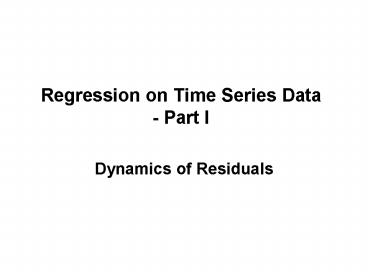Regression on Time Series Data - Part I - PowerPoint PPT Presentation
1 / 20
Title:
Regression on Time Series Data - Part I
Description:
Check Stationarity of Residuals for Stability of the Relationship Co-integration ... Coefficient of price is positive. DW is too low - serial correlation of ... – PowerPoint PPT presentation
Number of Views:40
Avg rating:3.0/5.0
Title: Regression on Time Series Data - Part I
1
Regression on Time Series Data- Part I
- Dynamics of Residuals
2
Forecasting Using Regression
- Watch for Spurious Regression
- Check Stationarity of Residuals for Stability of
the Relationship Co-integration - Learn Modeling Techniques for Reducing Residuals
to WN - Aware of Translating The Forecasting Problem to
That of Independent Variables
3
Integrated Process
- Integrated Process I(1)
- (1 - L)Yt ARMA(p, q)t
- Key Model (Hypothesis) for Macroeconomic
Variables - Uncertainty of the Long Run Path
4
Spurious Regression
- Two I(1) variables could exhibit significant
correlation, without an underlying relationship.
5
Spurious Regression Demonstration
- Two independent random walk series are
generated - Y1t Y1t-1 e1t e1t is WN(s1)
- Y2t Y2t-1 e2t e2t is WN(s2)
- Regression of Y1 on Y2 is computed.
6
Key Reminders
- The regression must make economic sense
- Check the residual if stationary
7
Regression Modeling-1 - AR (1) Error -
- e t r e (t-1) u t
- ut is WN(s)
8
Regression Modeling 2 - Using the First
Difference -
- Use the first difference to reduce each series to
stationary - DYt a b DXt et
- Simple and practical, but may not be a best
approach.
9
Regression Strategy - 3
- The distributed lag regression model with lagged
dependent variables (Text. Ch. 10.5) - In a simplest form
- Yt a0 a1 Y(t-1) b1 X(t-1) et
- Does not require forecasting of the right hand
side variables.
10
Regression Modeling - 4
- Error Correction Model
- Yt a0 a1Y(t-1) b0Xt b1X(t-1)
et - It can be shown that the model is equivalent to
(see the next page for the the definition of l
and g and the derivation) - DYt a0 b0 DXt - l(Y(t-1) g
X(t-1)) et
Long run equilibrium relationship
11
Regression Modeling 4 (cont.)
Write the model as follows
12
Demand for Gasoline
- Regression 1
- Residuals might be non-stationary (t -1.80,
p0.07) - Coefficient of price is positive
- Forecasting PG
- Regression 2
- Coefficient of price is positive
- DW is too low -gtserial correlation of the
residuals
13
Demand for Gasoline cont.
- Regression 3
- DW is too low -gtserially correlated residuals
- Forecasting DPG
- Contaminated by influential observations
- Regression 4
- Low R-squared
14
Demand for Gasoline cont.
- Regression 5
- AR(1) for the residual for generating WN error
- Possibly unequal variance?
- An important modeling approach
- Regression 6
- Using lagged Y for generating WN error
- Inferior to Regression 5
- Still a useful modeling approach
15
Demand for Gasoline cont.
- Regression 7
- Needs the value of the independent variable for
forecasting - A theoretical problem the coefficient of G(-1)
should be less than 1.0 for stationarity.
16
AppendixAR(1) Error
17
Cochrane-Orcutt Transformation
- For all Variables
18
Simple Regression Case
- Model
- Transformation
Use
19
Estimation of r
- 1. Use r 1
- 2. Use r1 of the residual of the
- standard regression.
20
Implications of Using r 1
- 1) First Differences as Regression Variables
- DY t Y t - Y (t-1)
- DX t X t - X (t-1)
- 2) Regression without the Intercept
- DY t b1 DX t at































